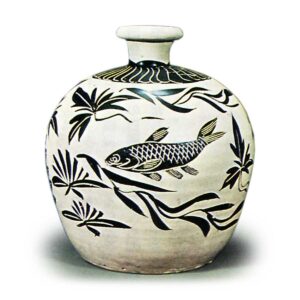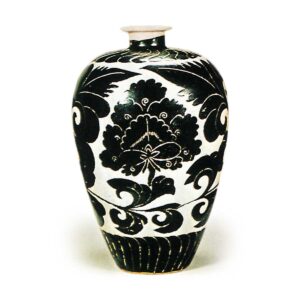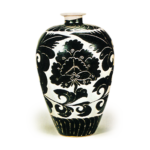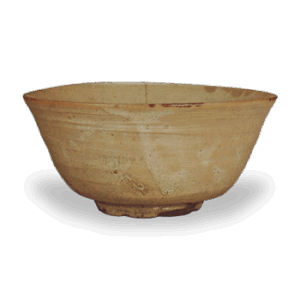

The largest kiln site in North China is centered in the Hebei Province of Jizhou. The kiln produced celadon called Sui celadon as early as the Sui Dynasty, but it was not until the end of the Tang Dynasty that products generally known as porcelain from the Jizhou kilns began to be produced actively, with the peak of production occurring from the Northern and Southern Song to the Yuan (Golden) Dynasty, although pottery production continued after the Ming and Qing Dynasties until the present day. The Song dynasty wares from this kiln were widely circulated early on and were considered to be representative of Song porcelain, but their nature became clear after the excavation of the town of Hujia, which was buried under loess. The following is a brief description of the types of Sung dynasty wares. (1) White-glazed earthenware: Because the grayish clay of the porcelain province does not have a bright skin, it is usually coated with white mud, and when a colorless water glaze is applied over it, the ware looks as if it has been covered with white glaze. To be precise, this type of pottery should be called “plain white glazed pottery,” but it is commonly referred to as white glazed pottery. (The white slip was scratched off to reveal the grayish-brown color of the clay, resulting in the appearance of grayish-brown engraved lines on a white ground or white painted floral motifs on a grayish-brown background. This is called “kakuri-oshi” (scraping off the white ground). (3) The opposite of kuro-ji-kakurikoshi (2) is done by applying black clay and scraping it off. (4) Kurojichi-kakuri-oshi (4) is a compound of (2) and (3), in which white makeup is applied and then black mud is applied, and then the surface is scraped off so that it stops at the white layer below. In this way, black patterns appear on a white background, or conversely, white patterns appear on a black background, creating a beautiful contrast. This is one of the most highly regarded examples among the porcelain wares produced by the Giju kilns. (V) Painted Koryo: Painted with black mud on a white painted surface, this is an abbreviated version of the “Kakidoshi” style of painting on a black and white ground. This is the simplest technique and became the mainstay of works after the Yuan dynasty (1268-1368). The name “painted Koryo” was given by an Edo period person who mistakenly thought that this piece was made in Korea, and it should originally have been called “black on white. (6) Some of the green-glazed wares (2) and (5) were kiln-dried twice by covering them with green or peacock-blue low-fired glazes, and are called green-glazed wares. This type of ware is thought to have originated under the influence of Persian blue-glazed and black-glazed ceramics. (7) Sung three-color: A three-color style in the vein of Tang three-color, in which the pattern is obtained by dividing the colored pattern with engraved lines. Pillows with poetic inscriptions are examples.
(VIII) Sung red glaze: White-glazed porcelain bowls and plates overlaid with floral motifs in low-fired red, green, and yellow. It is said to be the first red painting in China. In addition, various other techniques were used, including neriage, sumi-nagashi, persimmon glaze, candy glaze, Henan tenmoku, oil drop tenmoku, and white Tsui line pottery, and together with the scale of the kiln sites located in Hebei, Henan, and Shanxi Shandong, it is considered the largest kiln in China.








